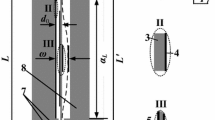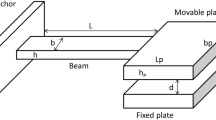Abstract
In this paper, a novel method has been developed to control the pull-in voltage of the fixed-fixed and cantilever MEM actuators and measure the residual stress in the fixed-fixed model using of the piezoelectric layers that have been located on the upper and lower surfaces of actuator. In the developed model, the tensile or compressive residual stresses, fringing-field and axial stress effects in the fixed-fixed end type micro-electro-mechanical systems actuator have been considered. The non-linear governing differential equations of the MEM actuators have been derived by considering the piezoelectric layers and mentioned effects. The results show that due to different applied voltage to the piezoelectric layers, the pull-in voltage can be controlled and in the fixed-fixed type the unknown value of the residual stress can be obtained.







Similar content being viewed by others
References
Afrang S, Abbaspour E (2002a) A low voltage electrostatic torsional micromachined microwave actuator. In: Proceedings of the 2002 IEEE international conference on semiconductor electronics (ICSE 2002) Penang, Malaysia, pp 100–104
Afrang S, Abbaspour E (2002b) A low voltage capacitive micromachined microwave actuator. In: Proceedings of the 2002 IEEE international conference on semiconductor electronics (ICSE 2002) Penang, Malaysia, pp 110–114
Balaraman D, Bhattacharya SK (2002) Low-cost low actuation voltage copper RF MEMS actuators. In: Proceeding of the Microwave Symposium Digest, 2002 IEEE MTT-S International, Seattle, WA, vol. 2, pp 1225–1228
Borwick RL, Stuper PA, Denatale J (2003) A hybrid approach to low-voltage MEMS actuators. In: Proceedings of the 12th international conference on solid state sensors actuators and microsystems, Boston, MA, vol. 1, pp 859–862
Chang R, Becher D, Feng M (2003) Low-actuation voltage RF MEMS shunt actuator with cold actuatoring lifetime of seven billion cycles. J Microelectromech Syst 12(5):713–718
Crawley EF, de Luis J (1987) Use of piezoelectric actuators as elements of intelligent structures. AIAA J 25(10):1373–1385
Donthireddy P, Chandrashekhara K (1996) Modeling and shape control of composite beams with embedded piezoelectric actuators. Composite Struct 35(2):237–244
Ghodssi R, Zhang X, Chen K-S, Spearing SM, Schmidt MA (1999) Residual stress characterization of thick PECVD oxide film for MEMS application. In: Proceedings of the 46th international symposium of the American Vacuum Society, Seattle, 25–29 October1999
Hah D, Hong S (2000) A low voltage actuated micromachined microwave actuator sing torsion springs and leverage. IEEE Trans Microw Theory Tech 48(12):2540–2545
Kahn H, Heuer AH (2001) Thermal stability of residual stresses and residual stress gradients in multilayer LPCVD polysilicon films. J Ceram Process Res 3(1):22–24
Milsom RF, Reilly NHC, Redwood M (1977) Analysis of generation and detection of surface and bulk acoustic waves by interdigital transducers. IEEE Trans Sonics Ultrason SU-24:147–166
Mukherjee T, Fedder GK, White J (2000) Emerging simulation approaches for micromachined devices. IEEE Trans Comput Aided Des Integr Circuits Syst 19:1572–1589
Osterberg P (1995) Electrostatically actuated microelectromechanical test structures for material property measurement. Ph.D. thesis, MIT, Cambridge
Osterberg PM, Senturia SD (1997) M-TEST: a test chip for MEMS material property measurement using electrostatically actuated test structures. J Microelectromech Syst 6(2)
Park JY, Kim GH, Chung KW, Bu JU (2001) Monolithically integrated micromachined RF MEMS capacitive actuators. Sens Actuators A 89:88–94
Peroulis D, Pacheo SP, Sarabandi K (2003) Electromechanical considerations in developing low-voltage RF MEMS actuators. IEEE Trans Microw Theory Tech 51(1):259–270
Quinn P, Palacios L, Carman G, Speyer J (1999) Health monitoring of structures using directional piezoelectrics. In: Proceedings of 1999 ASME mechanics and materials conference, Blacksburg, 27–30 June 1999
Rezazadeh GH, Svetlitsky VA (1997a) Fluid flow impact on dynamic stability of the straight rod under compression and torsion conditions. J VESTNIK BMSTU 3:32–39
Rezazadeh GH, Svetlitsky VA (1997b) Fluid flow impact on static stability of the straight rod under compression and torsion conditions. J Acad Sci Russ Mech Solids 3:176–182
Senturia SD (1998) CAD challenges for microsensors, microactuators, and microsystems. Proc IEEE 86:1611–1626
Senturia SD, Aluru N, White J (1997) Simulating the behavior of MEMS devices. IEEE Comput Sci Eng 4(1):30–43
Author information
Authors and Affiliations
Corresponding author
Rights and permissions
About this article
Cite this article
Rezazadeh, G., Tahmasebi, A. & Zubstov, M. Application of piezoelectric layers in electrostatic MEM actuators: controlling of pull-in voltage. Microsyst Technol 12, 1163–1170 (2006). https://doi.org/10.1007/s00542-006-0245-5
Received:
Accepted:
Published:
Issue Date:
DOI: https://doi.org/10.1007/s00542-006-0245-5




